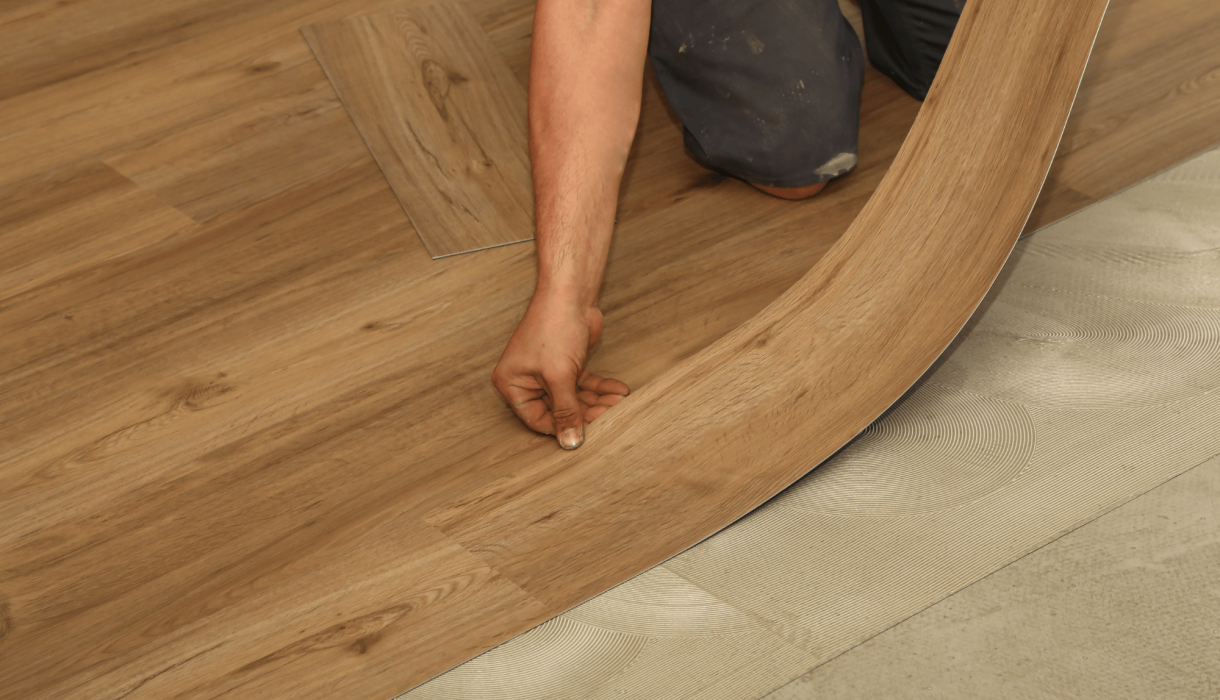Sheet vinyl flooring remains one of the most practical flooring choices for many homes. It’s durable, water-resistant, and comes in countless styles to match any decor. But getting a professional finish isn’t as simple as rolling out the material and cutting around the edges. At Abernethy Bespoke Flooring, we’ve installed countless vinyl floors across Wigan and the North West, and we’ve perfected our technique. Let me walk you through how we tackle sheet vinyl installation to achieve those perfect results.
Getting Your Space Ready
Before a single piece of vinyl touches the floor, proper preparation makes all the difference. First, we clear the room completely. Furniture, appliances, and sometimes even toilets need to come out to ensure we can lay the vinyl properly. Half-measures lead to poor results, so we don’t cut corners here.
The subfloor preparation is absolutely vital. Any bumps, dips or imperfections will show through your vinyl flooring, especially in areas with direct light. Our Floor Prepping Service ensures every surface is properly prepared before installation begins.
For concrete floors, we check thoroughly for moisture issues. Vinyl traps moisture, which can lead to mould and adhesive failure if not addressed. Wood subfloors need checking for loose boards, squeaks, and protruding nails. Sometimes we’ll need to sand high spots or fill low areas with levelling compound to create that perfect base.
Temperature matters too! We always let the vinyl sit in the room for at least 24 hours before installation. This helps it adjust to the room’s temperature and humidity, making it more flexible and easier to work with. Vinyl that’s too cold can crack when unrolled, while vinyl that hasn’t acclimated might expand or contract after installation.
Measuring and Cutting: Precision is Key
Accurate measurements prevent wasted material and botched installations. We measure the room at its widest points in both directions, then add about 75-100mm to each measurement. This overage gives us room to work with when fitting the vinyl against walls and around fixtures.
When cutting vinyl, we follow a careful process:
- We rough-cut the sheet slightly larger than needed
- Position it carefully in the room and let it settle
- Make precise cuts working from the centre outward
- Use a sharp utility knife with fresh blades for clean edges
For complicated room layouts, we sometimes make paper templates first. This is particularly useful around toilet flanges, doorways, or built-in cabinetry. Getting these cuts right the first time saves material and ensures a professional finish.
One trick we’ve perfected over years of Vinyl Flooring installations is making relief cuts in corners. This prevents the vinyl from bunching up and creates crisp, clean corners. Small diagonal cuts in inside corners allow the vinyl to lie flat without forcing it, which could cause tearing.
Adhesive Application: Different Methods for Different Situations
There are two main ways to install sheet vinyl: the perimeter bond method and the full-spread method. The right choice depends on the size of the room, expected foot traffic, and the manufacturer’s recommendations.
Perimeter Bond Method
For smaller rooms under about 12 square metres, we often use the perimeter bond method. This involves applying double-sided tape or adhesive around the edges of the room and at seams (if any). The vinyl’s weight and the friction against the subfloor keep the middle sections in place.
This method works well in guest bathrooms or utility rooms with less foot traffic. It’s quicker to install and easier to remove later if needed. However, it’s not suitable for larger spaces where the vinyl could shift over time.
Full-Spread Method
For kitchens, main bathrooms, and larger areas, we recommend full-spread adhesive application. This creates a permanent bond between the vinyl and the subfloor across the entire surface area. While it takes longer to install, the results last much longer and stand up better to heavy foot traffic.
The technique requires care and experience: fold back half the vinyl, apply adhesive to the exposed subfloor with a notched trowel, then carefully roll the vinyl back into place, working from the centre outward to push out air bubbles. Then repeat with the other half of the room.
Temperature and humidity affect how quickly adhesive sets, so we’re always mindful of working time. Rush the process, and you’ll trap air bubbles; wait too long, and the adhesive won’t bond properly. Our experienced LVT Floor Fitters have mastered this timing through countless installations.
Tackling Tricky Areas
Doorways and transitions between rooms require special attention. We typically cut the vinyl to extend just past the doorway, then install appropriate threshold strips to create a clean transition while protecting the vinyl edge from damage.
Built-in fixtures like toilets present another challenge. Rather than trying to cut the vinyl perfectly around the toilet base (which is nearly impossible), we remove the toilet completely, install the vinyl with a clean cut around the waste pipe, then reinstall the toilet on top of the new flooring. This creates a watertight seal and a much cleaner finish.
Pipes for radiators or sinks require special cuts. We make a small hole where the pipe will come through, then cut from the nearest edge to that hole. After fitting the vinyl around the pipe, we use silicone sealant to create a watertight seal.
For those seeking more decorative flooring options, our Herringbone Floor Fitters can create stunning patterned floors that add character and distinction to any space.
Finishing Touches Make the Difference
The final details determine whether an installation looks professional or amateur. Here’s where attention to detail really matters:
After the vinyl is secured, we carefully check every edge and corner. Any slight gaps between the vinyl and the wall will be covered by replacing skirting boards or adding beading. This creates a clean, finished look while protecting the vinyl edges from damage.
In wet areas like bathrooms and kitchens, we apply waterproof silicone sealant along the edges where the vinyl meets walls, bathtubs, or shower trays. This prevents water from seeping underneath and potentially causing damage to the subfloor or allowing mould growth.
For rooms with underfloor heating, we make sure the system has been off for at least 24 hours before installation and remains off for 48 hours afterward. This allows the adhesive to cure properly without being affected by temperature changes.
When DIY Isn’t the Right Choice
While some handy homeowners might tackle vinyl installation themselves, there are several situations where calling professionals makes sense:
Large rooms often require seams where two pieces of vinyl must be joined together. Getting these seams right requires experience and special tools to create nearly invisible joints that won’t catch dirt or lift over time.
Complex room layouts with multiple doorways, built-in fixtures, or unusual shapes make installation much more challenging. What looks simple on paper often becomes complicated in practice, especially when working with a material that doesn’t stretch or forgive mistakes easily.
Subfloor issues like significant unevenness, moisture problems, or structural concerns need professional assessment. Installing vinyl over these problems just hides them temporarily while potentially creating bigger issues down the road.
Our team at Abernethy Bespoke Flooring brings years of experience to every job. We’ve seen and solved virtually every installation challenge, ensuring your new vinyl floor looks fantastic and performs perfectly for years to come.
Maintain Your New Floor
Once your sheet vinyl is installed, proper maintenance will extend its life significantly. We recommend:
Sweep or vacuum regularly to remove grit and debris that can scratch the surface. Use a damp mop with a mild cleaner specifically formulated for vinyl flooring – harsh chemicals can damage the finish.
Place mats at entrances to catch dirt before it reaches your vinyl floor. Use felt pads under furniture legs to prevent scratches when moving chairs or tables.
Clean spills promptly, even though vinyl is water-resistant. Standing liquid can sometimes seep through seams if left too long.
For more specific advice about caring for your particular vinyl flooring, just ask our installation team. We’re happy to provide guidance based on the exact product installed in your home.
Professional Results Make the Difference
While laying sheet vinyl flooring might seem straightforward, achieving truly professional results requires experience, proper tools, and attention to detail. Our team at Abernethy Bespoke Flooring brings all three to every installation project.
If you’re considering new vinyl flooring for your home or business in Wigan or the North West, contact us at 07495 424721 or email michaelabernethy@live.co.uk for expert advice and installation. We’ll help you select the perfect product for your needs and ensure flawless installation that stands the test of time.


